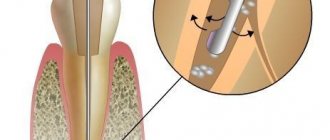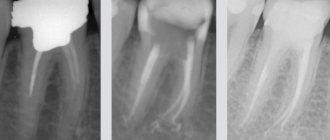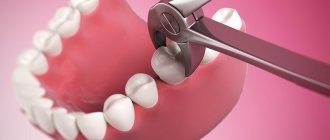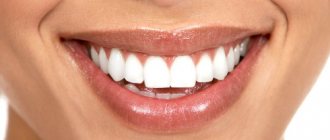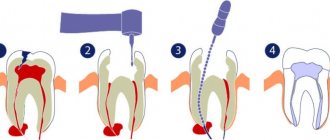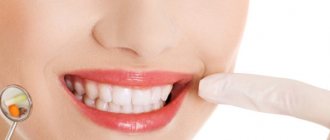The method of treating dental canals with resorcinol-formalin paste, proposed at the beginning of the last century in Germany, lasted more than 100 years. The effect of the paste is based on its mummifying and bactericidal effect on the affected dental pulp.
Due to this paste, the process of inflammation in the pulp stopped, and the paste firmly hardened and sealed the canal. It would seem that everything is fine, the pulp ceases to exist, the canal is closed.
But as it turned out, the use of resorcinol and formaldehyde in dentistry is categorically unacceptable.
Resorcinol-formalin method of root canal filling
This method involves the transformation of the pulp or its decay in the impassable part of the root canal into a plastic-like aseptic strand that is not subject to dissolution or decay under the influence of microflora and tissue fluid.
First, the carious cavity is prepared, the tooth cavity is opened and endodontic access is created. After this, the patency of the root canals is determined. Well-passable canals are mechanically and medicinally treated and sealed.
Pregnation with a resorcinol-formalin mixture is carried out in three to four visits. When carrying out the resorcinol-formaldehyde method, the contents of the root canal are impregnated with a resorcinol-formaldehyde mixture, which, after using a catalyst, polymerizes into phenol-formaldehyde plastic. As a result, the pulp, together with microorganisms, appears to be immured in this glass-like mass that does not decay. During the polymerization process, this mass shrinks, moving away from the canal walls and apical foramen, so the resorcinol-formalin method does not guarantee sealing of the canal lumen. To reduce shrinkage, the passable part of the canal should be filled with resorcinol-formalin paste.
After the resorcinol-formalin method, the tooth turns pink; when it penetrates the apical foramen, the resorcinol-formalin mixture causes irritation of periodontal tissue.
When is canal retreatment required?
If poor canal treatment was previously performed, the tooth becomes inflamed again. The infection extends beyond the root through the natural apical opening. Pulpitis becomes complicated - it turns into periodontitis, granuloma, cyst with the development of inflammatory processes at the root apex, which melt the surrounding bone tissue.
The purpose of the procedure is to eliminate infection of the dental canals and prevent the spread of inflammation to the periodontal tissues.
The main reasons for re-treatment of canals:
- Violation of mechanical processing techniques, use of outdated equipment, incorrect measurement of length - voids are formed in which bacteria multiply freely.
- The use of low-quality materials, questionable filling methods - the canals become depressurized, and infection easily penetrates them, causing inflammation.
- The jamming of fragments of dental instruments during the passage of canals by an insufficiently qualified doctor - if removal is impossible, they provoke an inflammatory process.
- Skipping additional channels without high-precision x-ray and microscopic diagnostics - an additional branch channel invisible to the eye is not treated for infection.
The need to re-treat dental canals indicates a violation of previous treatment protocols, the use of low-quality consumables and insufficient technical equipment of the dental clinic.
In our Center, the likelihood of medical errors and inaccuracies in diagnosis is reduced to zero
We use high-precision diagnostic equipment, functional tools and high-quality materials. The use of a microscope is mandatory and is already included in the price. Modern technologies allow the endodontist to carry out treatment so that the patient forgets about dental problems forever.
Levin Dmitry Valerievich Chief physician and founder of the Doctor Levin center
Silver plating method for root canal filling
The silvering method involves soaking the impassable part of the root canal with silver nitrate. After the restoration of silver, a thin film of metallic silver (“silver mirror reaction”) is deposited on the walls of the micro- and macrochannels, “burying” the microflora in the thickness of the dentin. As a result of the interaction of silver with pulp proteins, silver albuminates are formed, which “preserve” the pulp, turning it into an aseptic strand that is not subject to putrefactive decay. In addition, the presence of silver in the canal, which has a long-term antiseptic (more precisely, oligodynamic) effect, prevents the growth of microflora and the development of inflammatory complications from the apical periodontium.
Impregnation using the silvering method is also carried out in 3-4 visits.
Stages of revision and endodontic retreatment
To correct the mistakes of previous therapy, unfilling, thorough cleaning, elimination of inflammation, and re-filling the entire length of the canal are performed under the control of a dental microscope.
- Diagnostics Spot shot, computed tomography, diagnostic revision using a microscope
- Pain relief Local anesthesia of the working area or immersion in controlled drug sleep
- Tooth isolation The use of a rubber dam is mandatory to protect against infection penetration into the treated canals
- Canal treatment Removal of old material, mechanical cleaning with length measurement using an apex locator, medicinal treatment
- Filling canals Using BeeFill 3D technology to hermetically fill canals with hot thermoplastic gutta-percha
- Restoration of the tooth shape Restoration of the tooth under a crown or anatomical restoration with high-quality materials to avoid re-infection
The number of visits to the clinic depends on the presence of inflammation at the root of the tooth and its size:
- If the inflammation is minor - treatment in 1 visit according to the standard protocol with the listed stages.
- If the size of the cyst is more than 5 mm, another 1-2 visits will be required for an additional stage of drug treatment. After treatment of the canals, a medicinal preparation based on calcium hydroxide is placed for 2-3 weeks and a temporary filling is installed. After X-ray control, if the dynamics are positive, the canals are constantly filled, and the shape of the tooth is restored.
Klimova Maria Nikolaevna
Dentist-therapist
11 years of experience
Specialist in teeth treatment and whitening. Performs high-quality restorations using a dental microscope.
More details
Combination of silvering method and resorcinol-formalin method
To increase the efficiency and reliability of impregnation methods, it was proposed to combine the silver plating method and the resorcinol-formalin method. In this case, the silvering method is first carried out, in which the walls of the micro- and macro-channels are covered with a film of metallic silver. Then impregnation is carried out with a resorcinol-formalin mixture, as a result of which the pulp in the impassable part of the root canal turns into an aseptic plastic-like strand that is not subject to dissolution or decay under the influence of microflora and tissue fluid.
Guarantee
Endodontic dental treatment in our Center is carried out in the LifeTime Warranty format in accordance with the Center’s Unified Quality Standards
Retreatment of dental canals is a painstaking work that requires the experience of a doctor, the use of modern high-precision equipment, high-quality materials, functional tools and high-quality equipment.
We have warned against the risks of possible complications at every stage, so we can safely provide a lifetime guarantee for treatment and re-treatment of canals.
- Modern support from high-precision diagnostics to a dental microscope .
- Safe filling materials of the latest generation from trusted manufacturers with high aesthetic and strength characteristics.
- The Center employs highly qualified endodontists who save even teeth sentenced to extraction .
Mummification of the contents of the impassable part of the root canal
The term “mummification” in dentistry refers to the prevention of microbial decomposition of the pulp by impregnating it with potent antiseptics (thymol, camphor, iodoform, cresol, parachlorophenol, etc.). For this purpose, a cotton swab moistened with potent, slowly dissolving antiseptics, or a paste containing mummifying substances, is placed into the tooth cavity at the mouth of the root canals, and the tooth is sealed. This method is currently practically not used due to its low efficiency.
In what cases canal retreatment is not carried out?
There are a number of situations that, despite all the desire and diligence of the endodontist, complicate treatment and make it ineffective:
- vertical tooth fracture
- severe destruction of the anatomical crown with impossibility of restoration
- tooth mobility due to periodontal inflammation
In such cases, the doctor cannot predict success and guarantee long-term results. A rational decision would be not to spend money on treatment without a guarantee, to perform a careful removal and install an implant.
Crowns: when the main part of the tooth is already destroyed, but its roots are still intact
If the tooth root can be somehow preserved, but its main part is completely or practically lost, then an excellent option is prosthetics using crowns that resemble a cap in the shape of a natural tooth, installed on pre-ground incisors, or on a stump insert installed in the canals roots.
In the process of prosthetics of anterior incisors, increased aesthetic requirements are put forward to materials. First of all, the materials should look as natural as possible, while the requirements for the reliability of the frame are not as high as for chewing teeth, because they are significantly less exposed to stress.
Often, dentures for incisors are made from Emax ceramics or feldspathic ceramics. If it is necessary to install a bridge, then zirconium oxide is used as the frame material. Whereas, metal-free structures look natural in any lighting.
It is worth noting that using CEREC technology, you can make a permanent crown or veneer, and install it in just one to two hours. This technology allows you to hide the defect and save a lot of money, because in this case the manufacture of a non-permanent prosthesis is not required.
Cosmetic prosthetics
It is not uncommon for the incisors to be practically healthy, but for one reason or another the patient does not like their shape, or the incisors are damaged: there are small chips and other damage to the tooth enamel, chronic fluorosis. In such cases, special overlays can be an excellent solution - these are veneers, ultraneers. These types of cosmetic prosthetics of incisors consist of applying thin ceramic plates to their surface.
ultraneers are thinner than other varieties and require a smaller area of tooth preparation. However, simple veneers are much more wear-resistant and can hide a large area of dental defect. They can hide defects such as cracks, chips, deviations in the shape and color of tooth enamel.
Often, different types of onlays are installed in pairs, or on all front incisors, since a tooth with such prosthetics can stand out greatly.
The choice of type of onlay depends on the area of damage to the incisor tissue, as well as the individual requirements of the patient.
Removal of a resorbed tooth in dental clinics in Moscow
- Reiter
- Saratovskaya street, house 24
- +7 (495) 650-… show all
- daily, 9:00–21:00
4.0 ratings: 4
- Implacity
4.6 ratings: 5
- Kdk dent
3.5 ratings: 6
- Arm clinics
3.5 ratings: 6
- Artdent
3.5 ratings: 6
- Dentistry Dmitrovich and colleagues
3.9 ratings: 10
- Dental fantasy
5.0 ratings: 3
- Dent prestige
4.1 ratings: 7
- Bison
4.0 ratings: 10
- Avantis
4.2 ratings: 11
- Vita+ troparevo
4.0 ratings: 4
- White rainbow
4.4 ratings: 5
Further
Prosthetics of incisors when they are completely destroyed
In case of root loss, “bridges” or artificial roots using the implantation method are used in the process of incisor prosthetics. The best option in the absence of inflammation in the oral cavity is implantation immediately after surgical removal of the incisor and prosthetics using a non-permanent crown, which must be removed from the bite.
Implantation is an ultra-modern methodology for recreating damaged teeth in the absence of a root part. Implants are implanted into bone tissue. Due to the porous and branched structure of the implant surfaces, the bone seems to grow into it - a similar process is called osseointegration or engraftment.
Engraftment lasts for three to six months, its duration depends on the installation position, the manufacturer of the implant, as well as the individual inclinations of the patient. At the end of this period, a permanent prosthesis - a crown - is installed on the implant. While the implant is healing, to hide the defect, the patient is given temporary crowns or removable dentures, so-called “butterflies”, which are held on the patient’s teeth and do not involve their preparation.
Implantation allows the absolute restoration of both functional and aesthetic properties of the incisor. This is the only methodology that allows you to stop the death of jaw bone tissue.
In addition to significant advantages, the implantation technique also has some disadvantages, primarily these:
- The need for bone building, with the development of a lack of bone tissue or the proximity of the maxillary sinus.
- There is an urgent need to prevent inflammatory processes in the oral cavity.
- Duration of therapy.
- Unlikely, but not an absolute possibility of rejection.
Installation of a “bridge”, with preparation of completely intact teeth
The so-called “bridge” includes the required number of artificial teeth, its entire structure rests on a pair of the patient’s own teeth. A similar methodology is indicated when a pair of adjacent teeth are missing. In this case, dental crowns are fixed onto previously ground dental tissues; for this purpose, they are depulped and prepared for the crown, which can be called the main and quite significant drawback of the methodology. Its next disadvantage is the active death of bone in the area of missing teeth, as well as the increased function of the patient’s supporting teeth.
Also, “bridges” can be installed on implants.
Nowadays, “bridges” are rarely used for incisor prosthetics, but in some cases this is the only possible option. As in the case of a ban on the use of implantation techniques.
It is important to note that innovative methodologies for dentition restoration include “bridges” less and less often, especially in the process of closing single defects. And even in terms of price, an implant together with a crown can cost much less than a “bridge” of three units with mandatory depulpation and, of course, grinding of other teeth. You can verify this by reading the information below.
Clasp dentures are less popular options for dental prosthetics. However, just a couple of years ago, in the Russian Federation, both of these methods were among the most common options for prosthetics.
Partial removable dentures are temporary and made from polymer materials. After all, their use on an ongoing basis is prohibited, due to the increased likelihood of aggravating the problem of death of the bone tissue of the alveolar process of the upper jaw.
Another variation of non-permanent incisor prosthetics is the use of clasp dentures, improved removable structures used for partial edentia. The difference between this type of prosthetics and conventional removable prosthetics is the presence of a metal frame in the shape of an arc, made of light and high-strength metal. A plastic frame is attached to the arch, along with artificial teeth. Often, clasp is used for prosthetics of both front and chewing teeth.
